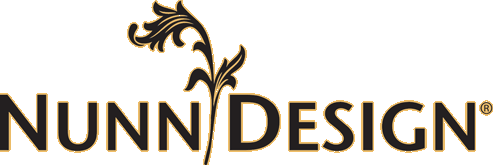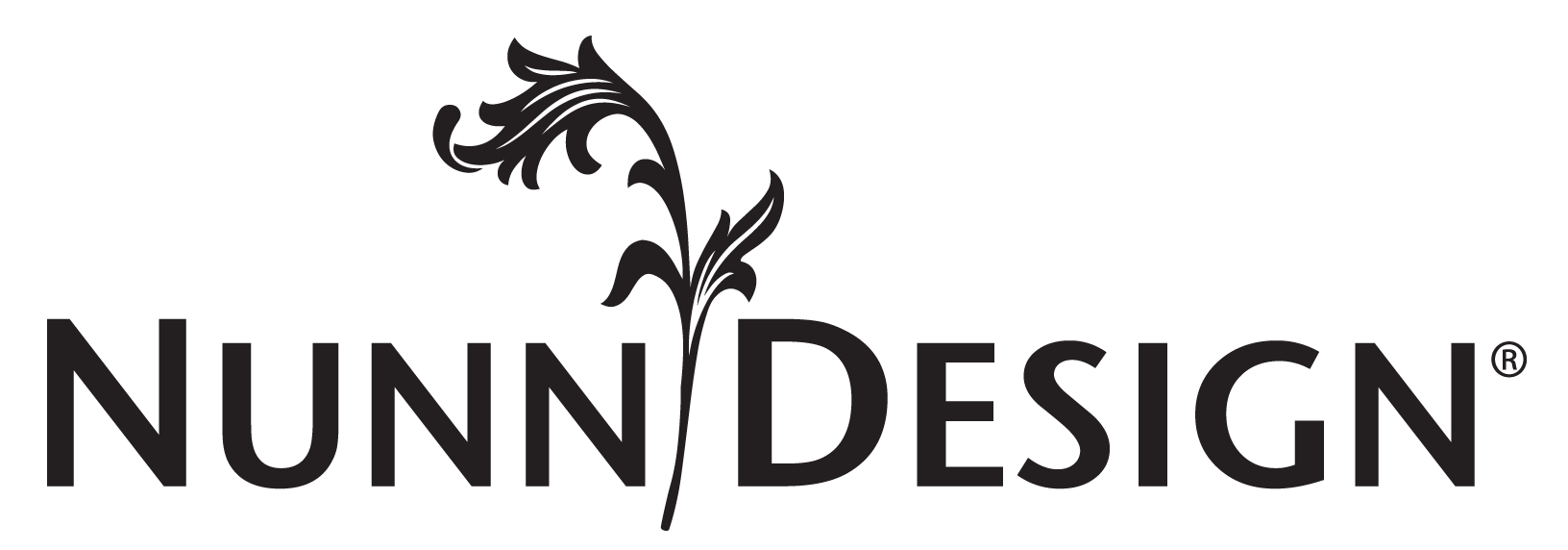Tutorials
Rubber Stamping on Epoxy Clay with Colorized Resin
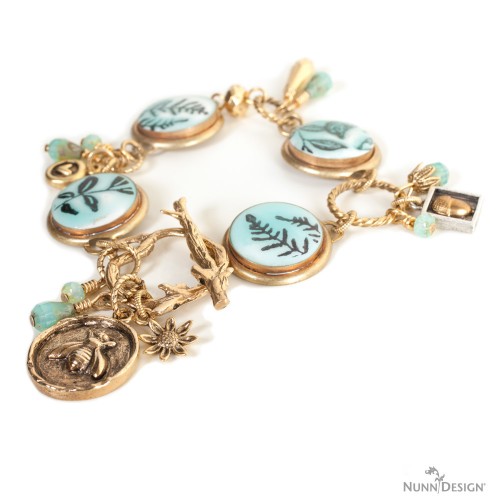
There are a few steps involved in creating this style of mixed media jewelry, I won’t deny it, these steps are fairly easy for a beginner, yet the look is sophisticated enough to make it worth the time for even the most experienced jewelry makers to try.
Another thing about this technique that makes it appealing, is that it is forgiving. If you don’t like the impression that you make with the rubber stamp, wipe it off. If you don’t like the look of the resin, wipe it off and start again. Having flexibility makes learning more enjoyable, don’t you think? Let me show you how.
Learn How!
Supplies:
Epoxy Clay-Epoxy Clay White
Nunn Design Patera Bracelet Large Circle
Rubber Stamps
Ink
Nunn Design 2-Part Resin
Castin’ Craft Colorants Yellow and Blue
Other Supplies:
Wet wipes
Toothpicks or headpins
Timer
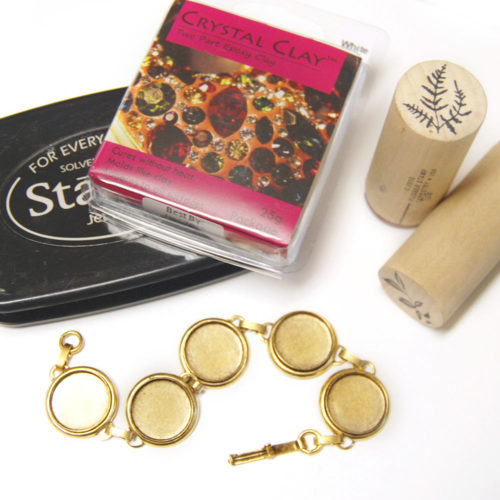
Add Epoxy Clay into Bezel
Step 1:
Follow the manufacturer’s instructions for the handling and mixing Epoxy Clay. For mixing the Epoxy Clay, it is best to wear your gloves. Pinch off two equal sized balls, approximately the size of a small pea, of Part A and Part B. Blend together fully until the clay is no longer marbled and is uniform in color. You have approximately 90-120 minutes of working time before the clay starts to harden, so take your time. Once the clay is thoroughly mixed, remove your gloves to make it easier to work with the clay.
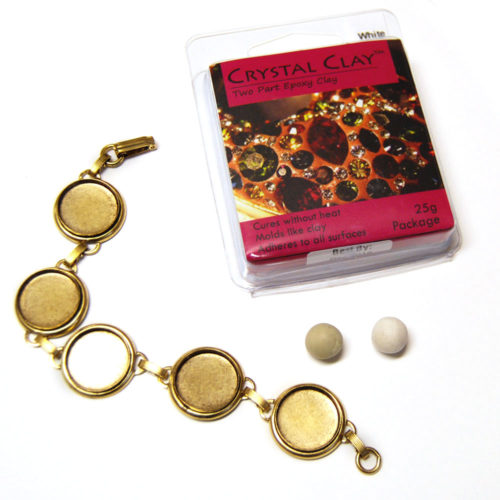
Step 2:
Roll the thoroughly mixed Epoxy Clay-Epoxy Clay between your palms until it forms a smooth round ball. Press the ball into your bezel and create an even smooth surface by patting down the clay with your fingers. You will want to have your clay flush even to the edge of the bezel. If you put too much clay in the bezel, the 2-part resin when applied will overflow and you will have clean up to do. If you do have too much clay, pinch off your excess and pat down your Epoxy Clay-Epoxy Clay until clay is even with the rim and continue to pat until you have a smooth surface.
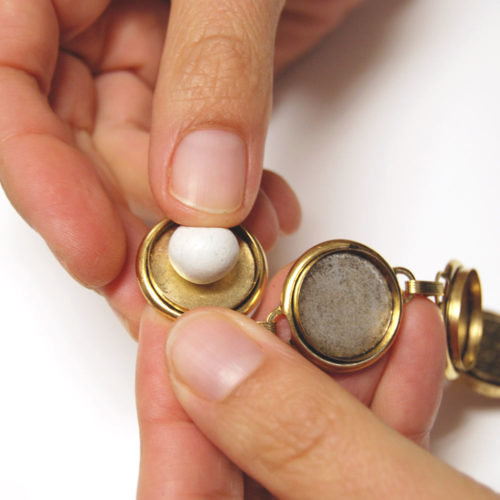
Step 3:
Using a wet-wipe, clean up any excess Epoxy Clay-Epoxy Clay that might have been left on the jewelry finding. The Epoxy Clay-Epoxy Clay hardens like cement, so cleaning it up now and being tidy as you go makes the process easier and the results so much nicer.
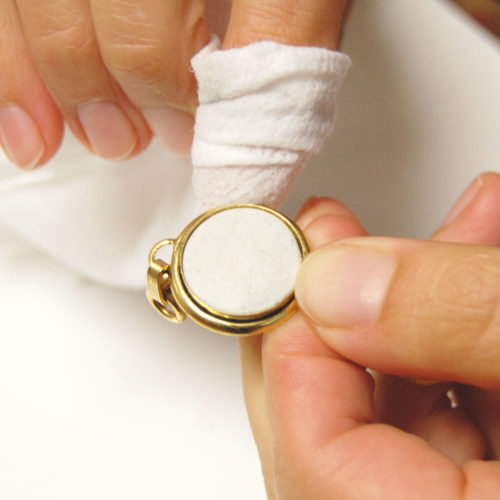
Apply the Rubber Stamp
Step 4:
Ensure that your ink pad is nicely inked so that you have an even coverage on your rubber stamp. I like to test my impression by stamping onto a sheet of white paper prior to actually stamping on the Epoxy Clay-Epoxy Clay. Once you are all inked up, place your rubber stamp upright over your epoxy filled bezel. Press down gently into the clay, creating a stamped image.
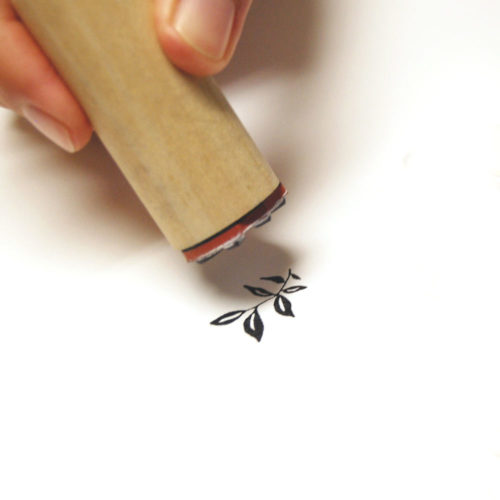
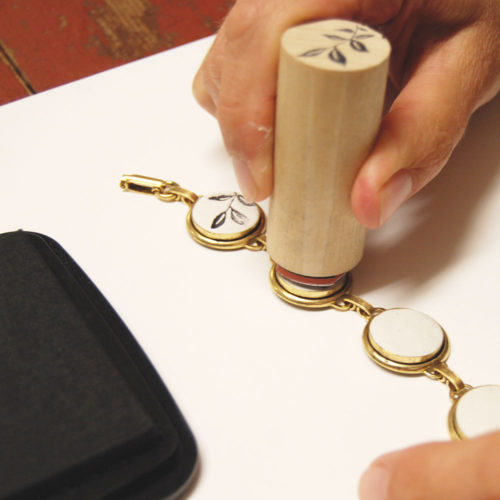
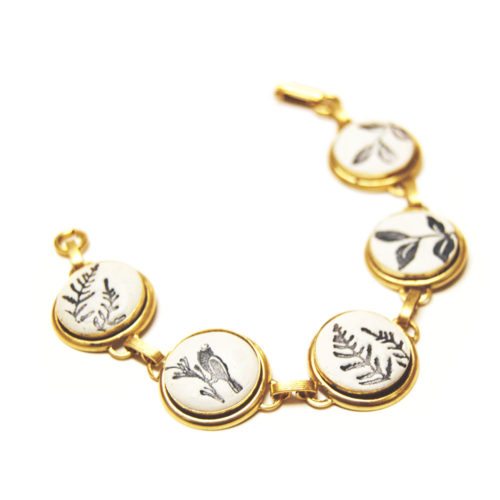
Step 5:
If you don’t like how your image looks stamped on the Epoxy Clay-Epoxy Clay, you can pinch off the stamped surface and add some additional clay to bring up your surface to be even with the side edge of your bezel and stamp again until you have it just the way you like it.
TIP: It is always a good idea to remove excess ink from your rubber stamp prior to storing them.
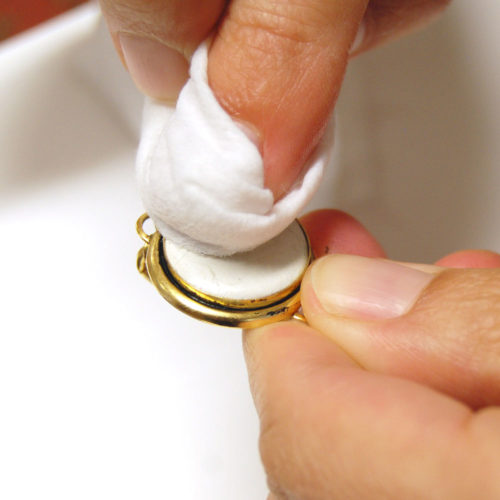
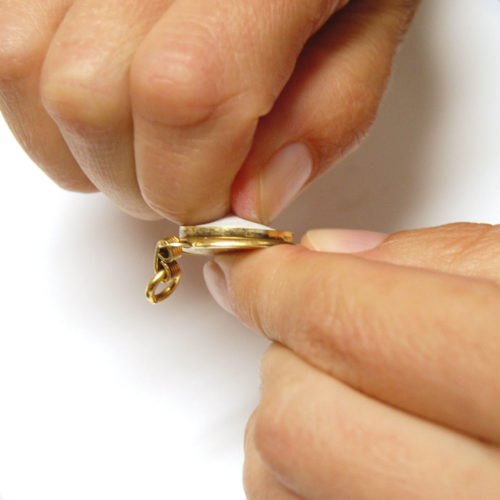
Preparing the Colorized Resin
Step 6:
Read the resin instructions for safety concerns regarding the Nunn Design Resin.
When I work with resin, I always:
- Place a large plastic bag over my work surface and tape it down.
- I make sure I have ventilation in my workroom.
- I wear gloves.
- I wear glasses (readers because I can’t see anymore. Plus it protects my eyes!).
- I have a pile of wet wipes handy.
- This is a great blog post that covers 20 Habits for Successfully Using Nunn Design 2-Part Epoxy Resin. Even if you are a seasoned resin mixer, this might be worth a read.
- You can also watch this great video on How to Mix Nunn Design Resin
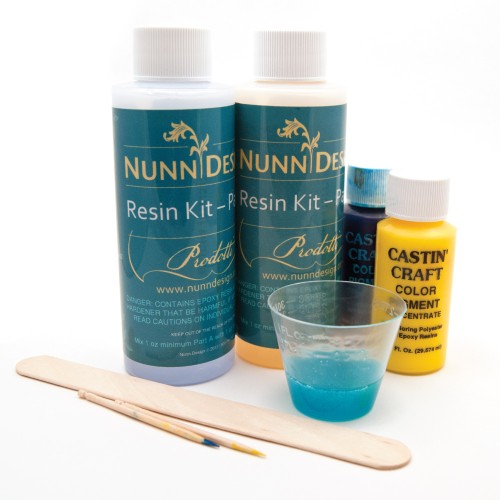
Step 7:
Mixing your resin: Place one cup (included in the Nunn Design Resin Kit) onto your table. For curing purposes, it is very important that the resin be an exact 1 to 1 ratio of Part A and Part B. I suggest getting your eyes level with the resin so you can see the lines on the measuring cup. Pour Part A of your resin kit up to the ½ fluid ounce mark on your measuring cup.
Pour Part B of your resin kit into the same cup until it is filled to the 1 fluid ounce mark. It is important to pour Part A first and then Part B. It is some chemical thing about the part B being heavier or something.
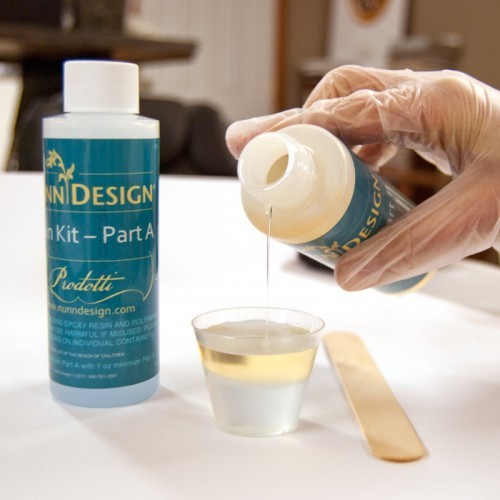
Step 8:
Set your timer for 2 minutes. Using the stir stick from your kit (a popsicle stick or coffee stir stick will work great too), slowly and carefully stir your resin scraping the sides as you stir. Stir for a minimum of 2 minutes. If your resin is still cloudy continue to mix until clear. After mixing is complete and your resin is clear, scrape both sides of your stir stick on the edge of your resin filled cup. Set the mixture under a warm lamp for 5 minutes. I like the lamps with the adjustable arms that can get right down next to the resin. This aids the air bubbles in the resin to rise to the surface and pop.
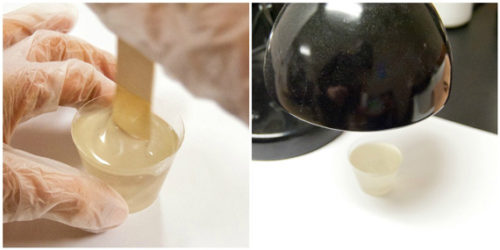
Step 9:
After your resin has been under the lamp for 5 minutes, pour a small amount of the mixed resin into a measuring cup. I like to use a toothpick or a headpin to add the pigment to the resin. You only need a tiny bit to color the batch. If the resin isn’t as opaque as you would like, add in a drop of the White Opaque Pigment. You can mix the full 1 fluid ounce of resin if you want, but I transfer the resin into smaller cups because it is easier to stir and less messy to move around when less full. To make this turquoise color, I mixed a headpin of yellow and blue pigment.
Tip: Be sure that the colorant does not equal more than 10% of your resin as having more than 10% could cause issues with curing!
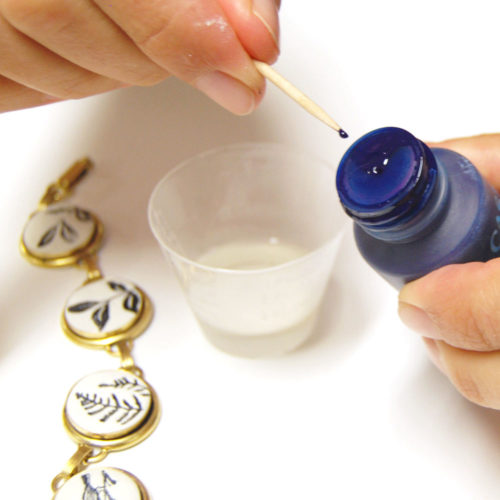
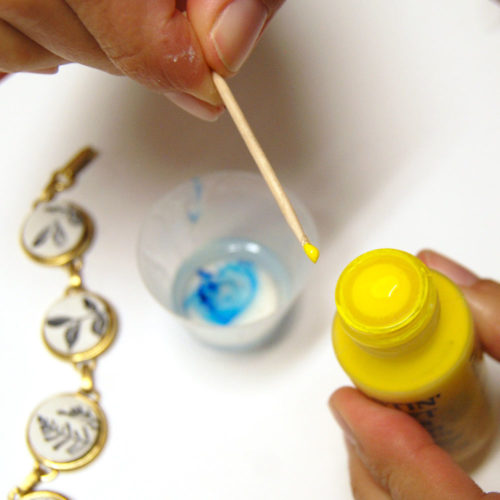
Step 10:
Drizzle the mixed resin onto the epoxy surface you want to colorize. It is best to under pour and then add more if necessary. Using a toothpick or a headpin will allow you to drag the resin over to the side edges. You can also use the toothpick or headpin to remove excess resin.
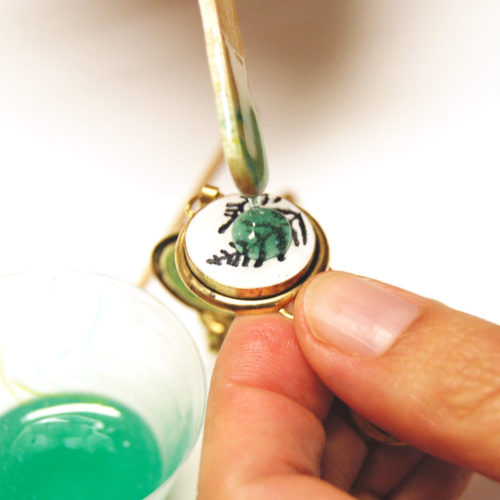
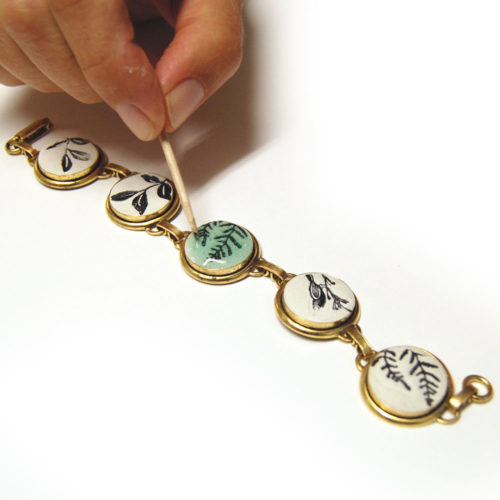
Step 11:
Using a wet-wipe, clean off any resin that might be on the sides of the bezel. Let the resin dry for 12-14 hours. It will be dry to the touch, but resin continues to cure over the next 72 hours. I like to put one of the small cups from the resin over the top to prevent from dust getting into the resin as it dries.
TIP: I have poured my colorized resin over uncured Epoxy Clay and have had no issues with the inks running. If you aren’t using Epoxy Clay and StazOn Ink, you may need to let the clay cure prior to pouring on the colorized resin.
Step 12:
For the bracelet sample that I created, I disassembled my Patera Bracelet by opening the links of the bracelet with a pair of needle nose pliers and reassembled it using elements to create a unique piece just to my liking.

Watch Videos:
Shop Supplies:
Shop Supplies WHOLESALE:
Shop Nunn Design Wholesale
Nunn Design has been supplying jewelry artists with findings for over 20 years. Shop wholesale jewelry findings for creative jewelry makers.
Shop Nunn Design!How to Purchase Wholesale?
If you are interested in becoming one of the many designers who trust their jewelry to Nunn Design Findings, please join us by registering to become one of our wholesale customers!
Please visit our Where to Buy Page for a listing of online stores that sell Nunn Design Findings retail.
If you enjoyed reading this post, please subscribe to our blog. Here are 10 Reasons Why to Subscribe and a place to do so!



